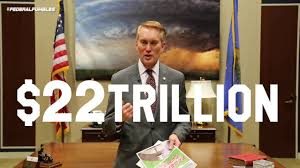
From government money spent on studying Russian wine to immigration, Oklahoma U.S. Sen. James Lankford is out with his fourth edition of Federal Fumbles, a listing of what he considers to be wasteful government spending.
He touched on some energy-related matters saying his latest edition takes a different approach to waste.
“We focus not only on waste of your tax dollars but also on waste in good government policy that prevents the federal government from working for you—or more recently from working at all due to the longest government shutdown in American history,” said the Senator.
He said of every issue cited in the latest edition also comes with a solution.
“Washington works for the American people and must be held accountable by the American people. Fumbles outlines a set of ideas about ways we can work together to make that happen,” he said.

Let’s highlight one of the issues. The High Cost Fund. If you’ve followed our stories in OK Energy Today about the Universal Service Fund and the Oklahoma Corporation Commission, you know something about it.
Sen. Lankford asks the question, “Have you ever felt like you were been ripped off? I’m sure rural Americans do if they paid for but did not receive better cell phone and internet service.”
Here is what he stated about the issue and his solution:
The High Cost Fund, now transitioning to the Connect America Fund (CAF), was originally created as a program
through the Universal Service Fund (USF) in 1996 to
help build telecommunication infrastructure in poorly
connected, mostly rural areas. Americans have paid
billions into those funds through USF fees on their
monthly phone bills, regardless of where they live.
In 2017 the USF disbursed a total of $8.8 billion.114
However, those dollars haven’t always been spent on
remote populations or in the rough terrain of rural
areas because it is more expensive to expand or upgrade services in these areas. Because of the high costs,
federal dollars are often spent to provide more options
in currently served communities.
The federal government estimates that the average
cost to make connections by laying fiber cable is
$27,000 per mile. The price increases exponentially
in rural areas with rocky terrain and dense forests.
Mobile broadband infrastructure is much more cost effective but can still prove difficult to deploy. Because of
that, CAF dollars are focused on already served areas.
If you live in rural America, you already know that your telephone and internet services have fallen behind. Swiftly advancing
technology has made it difficult to keep rural America up to speed.
The program has also experienced management issues and has been reviewed by GAO.115 Since GAO’s reviews, the FCC has increased oversight and streamlined its focus by transitioning to the CAF. However, the program still does not target areas that are truly underserved.
SOLUTION
The solution is pretty simple: the Federal Communications Commission (FCC) should target underserved
areas and examine the requirements for what served
means within its USF programs.
Since 2016 the FCC has examined the issues within the USF and pushed orders to improve the program. However, action is still
needed to ensure long-term certainty and fiscal sustainability of the USF. It is important that all stakeholders, cluding local carriers, consumers, state partners, and federal entities, work together to address the serious issues with this federal program.
The FCC is currently working on a USF budget reform order and making efforts to ensure greater financial certainty within the program. I am committed to working with the FCC on future reforms to best target funding. We cannot overlook new solutions like satellite broadband or large-scale rural Wi-Fi to also solve our
national connectivity. We should not just assume fiber
connectivity is the only way to connect America.





